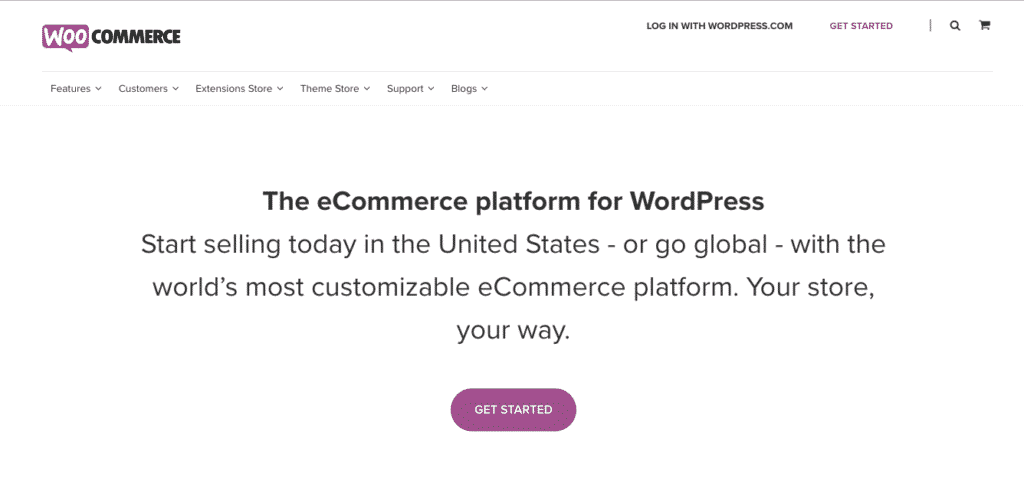In an economy where brick and mortar businesses are announcing closures and bankruptcies on an almost routine basis, online business, or e-commerce, continues to boast growth. E-commerce is the most effective and flexible way to reach potential customers in any location in the world at any time with the least amount of resources.
E-commerce accounted for 40% of online sales in the United States in 2018 with an 18% increase. It is expected to hit $4.5 trillion in 2021 and represents almost 10% of retail sales in the U.S.
Why Use E-commerce Platforms?
![]()
Source: Unsplash
E-commerce platforms such as Shopify and WooCommerce provide software that eliminates the need for large staffs, infrastructure, and high overhead. While Shopify is based in Canada, and the teams that make up WooCommerce are located across 60 countries, they both function as the engine behind an online business.
A day in the life of a small business owner involves communicating with its customers, processing transactions, marketing and email management to drive traffic, analyzing current traffic data and trends, checking and updating inventory, shipping product and various other tasks. These Shopify and WooCommerce streamline the process.
These e-commerce platforms serve to simplify the complexities of running and managing a business. Such platforms allow small business owners with varying levels of expertise to effectively manage an entire online sales and inventory process. In addition, these methods are beneficial to their users and customers.
So, if a small business owner wants to be most efficient and still have time to get some rest in the meantime, which of the two platforms would be the best choice?
Similarities between Shopify and WooCommerce
Well, let’s take a look at the benefits they both offer to business owners:
Maximize Sales:
- The ability to sell globally
- A full blogging platform
- Search Engine Optimization
- Flexibility to ship anywhere
- Reporting and tracking
Easy for you:
- Inventory and order management
- Automatic tax calculations based on customer location
- Summary at-a-glance dashboard
- Ability to use various payment gateways and integrations
- Mobile application to track financials, manage orders, receive real-time order alerts, etc.
User-Facing Benefits:
- 1-click selling app availability
- Coupon options for customers
- Countless theme options
- Domain name set-up
And, both www.ecommerce-platforms.com and www.codeinwp.com rank Shopify and WooCommerce as two of the leading e-commerce platform options overall.
Differences Between Shopify and WooCommerce
Now, let’s check out what differentiates each platform to both the advantage and potential disadvantage of a small business owner.
 Shopify Advantages
Shopify Advantages
Pricing
With Shopify, customers have a free 14-day trial, so you can decide if this platform works for your organization before you buy. Prices start at $29/month.
Accessibility
Shopify includes easy set-up, the fastest load time of any e-commerce platform, and the ability to sell on social media and in brick and mortar locations. In addition, Shopify is deemed as having everything you need right out of the box. It offers the ability to sell physical and digital products, downloads, services, and drop-shipping. Support is available 24/7 via phone, chat and email. The platform also offers fraud prevention.
Grows with You
Shopify is cloud-based and hosted so small business owners don’t have to upgrade or maintain software or web servers. This also makes the website scalable as your company grows. You can also buy an existing store online. The only requirement is simply having an internet connection available at any location for full functionality.
For your Customers
Shopify helps you reach a large audience and stay connected to your customers. Customer facing info can be in any language, including English, French, German, Japanese, Spanish, Portuguese, and Italian. The platform also sends an email to those who have abandoned their shopping cart to help small business owners recover lost sales. It’s the most feature-rich of all platforms. For your marketing needs, Shopify includes built-in marketing tools to create, execute and analyze campaigns on Facebook and Google.
Shopify Disadvantages:
Despite this inclusive packaging, Shopify has its weaknesses: weak Search Engine Optimization, the checkout isn’t customizable, apps are more costly than average, and the return process is unclear.
Also, personally, I find organizing themes for customer pages to be really obnoxious. Some business love Shopify’s mobile version enough to use it even if they’re not technically an e-commerce site. Shopify provides all kinds of templates for putting goods on display. However, if you want to add an additional page for SEO purposes, you better know how to code if you want to make it look nice.
 Woocommerce Advantages
Woocommerce Advantages
Pricing:
Offers a 15-day free-trail and 30-day money back guarantee. Hosting can be as cheap as $3.50 a month, but can quickly climb in expenses.
Accessibility:
WooCommerce uses WordPress software, which runs 26% of the web. It’s so easy to personalize that it’s considered the world’s most customizable platform. It’s also the best platform for Search Engine Optimization. WooCommerce offers the ability to integrate with accounting solutions and multiple service provider options.
For Your Customers:
Woocommerce features the ability to automatically show related products to customers for add-on sales. Customers will also have access to one-click refunds.
WooComerce Disadvantages:
Hosting can be expensive because of bundling costs and the need for a lot of extensions. It can be difficult to troubleshoot when technical difficulties surface because support is available only via FAQ and opening a support request online. Small business owners are also responsible for maintaining updates, backups, and website security. Unlike Shopify, there’s no abandoned cart recovery
Should You Use Shopify of WooCommerce?
Both Shopify and WooCommerce have the ability to equip small business owners with the tools to successfully manage their business.
Shopify is the top pick for those who want to have peace of mind knowing that hosting and cloud-based info is taken care of, who want to scale their business in the easiest and most efficient manner and have support readily available.
On the other hand, small business owners that already have a comfort level with WordPress software, prioritize SEO, and don’t mind maintaining their own updates, WooCommerce may be the way to go. Deciding which platform is better can be determined by the needs and expertise of each small business owner.